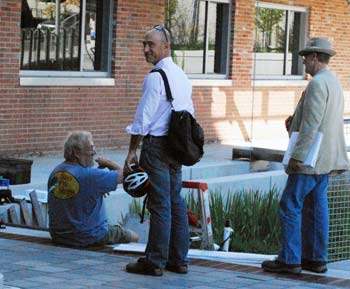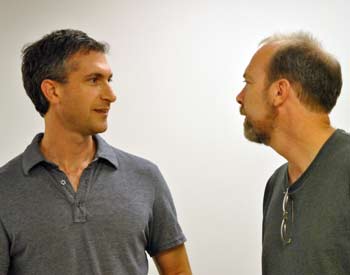Public Art Commission Eyes Uncertain Future
Ann Arbor public art commission meeting (Nov. 28, 2012): In their first meeting after the Nov. 6 defeat of a public art millage proposal, AAPAC members discussed the Percent for Art program’s future in the context of city council proposals that could reduce funding or eliminate the program entirely.

Margaret Parker, former chair of the Ann Arbor public art commission, attended AAPAC’s Nov. 28 meeting and volunteered to help with outreach and promotion. (Photos by the writer.)
Aaron Seagraves, the city’s part-time public art administrator, highlighted several projects that have been in the pipeline and that will likely be completed in 2013: a $150,000 hanging glass sculpture by Ed Carpenter, to be installed in the Justice Center lobby this spring; artwork for a new rain garden being built at Kingsley & First next spring; and public art for the East Stadium bridges, with a $400,000 budget. Artists haven’t yet been selected for those last two projects, but it’s hoped that the work will be finished by the end of 2013.
Much of the conversation among commissioners focused on how to improve promotion and coordination of the work they’ve done to date, and to explain their vision for public art in Ann Arbor.
“We’ve got a fair amount of work to do in the next few months,” said Marsha Chamberlin, AAPAC’s chair.
Two members of the arts community – former AAPAC chair Margaret Parker and Deb Polich, executive director of the Arts Alliance and president of Artrain, who had also co-chaired the “B for Art” millage campaign committee – attended the meeting. During public commentary, Parker volunteered to help with outreach efforts, and gave commissioners a list of suggestions for promoting the city’s public art program.
Also attending the Nov. 28 meeting was city councilmember Sabra Briere (Ward 1). She has proposed changing the public art ordinance to narrow the type of projects that could be tapped for public art funding. The effect would be to dramatically cut the amount of funds available for public art. A second proposal, by Jane Lumm (Ward 2), would simply eliminate the program. Both of those proposals were tabled by the council on Nov. 19. But at its Dec. 3 meeting, the city council is expected to act on yet another proposal – made by Marcia Higgins (Ward 4) – to appoint a committee to study the city’s approach to public art. Her proposal would also suspend the expenditure of funds, with several exceptions, that have accumulated for public art.
Update: At their Dec. 3 meeting, the city council voted to suspend the spending of funds accumulated through Ann Arbor’s Percent for Art program until April 1, 2013 – except for projects that are already underway. A committee consisting of Sally Petersen (Ward 2), Sabra Briere (Ward 1), Stephen Kunselman (Ward 3), Margie Teall (Ward 4) and Christopher Taylor (Ward 3) has been appointed to recommend amendments to the city’s public art program. The committee is charged with making a recommendation to the council by Feb. 15, 2013.
AAPAC faces other changes as well. At the Nov. 28 meeting, Chamberlin noted that Theresa Reid has resigned from the commission. Reid, who is executive director of the ArtsEngine at the University of Michigan, had been appointed to AAPAC in February 2012. In response to an email query from The Chronicle, Reid cited time commitments for work and family, and said her resignation was not related to the Nov. 6 defeat of the public art millage.
During the Nov. 28 meeting, Chamberlin urged commissioners to solicit potential candidates for a replacement. An appointment will be made with a nomination by the mayor and confirmation by the full city council. An application for all city boards and commissions is available on the city clerk’s website. [Full Story]







